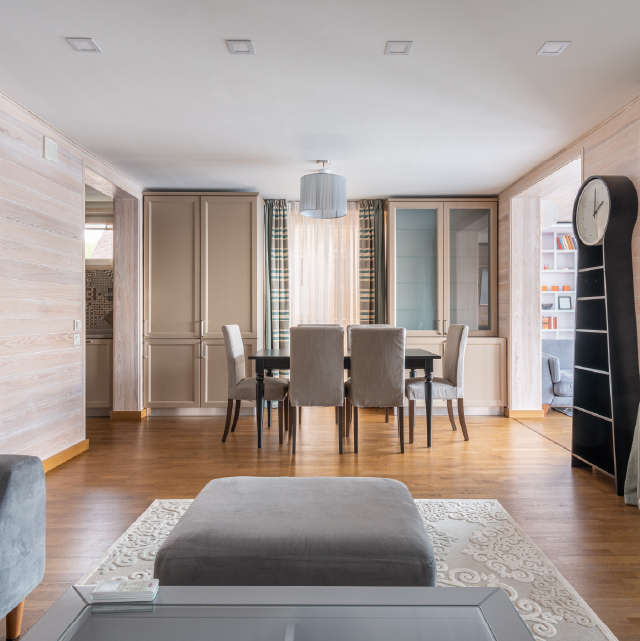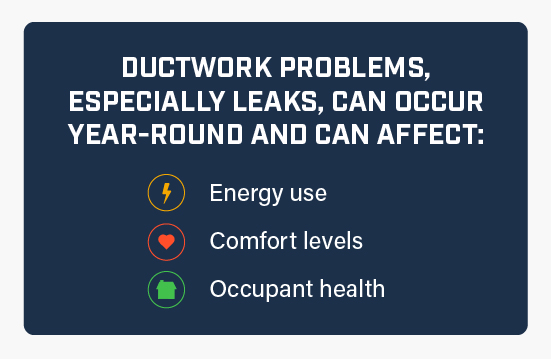
The ducts in your home may be tucked away behind walls, under floors, in ceilings, or snaking through crawlspaces. Because you don’t see your home’s ductwork often, it’s easy to forget about — until it affects the comfort levels in your home.
Defective ductwork not only makes rooms feel stuffy, but it can also lower the quality of indoor air and increase energy costs each month. By recognizing the signs of duct-related problems, you’ll take strides in improving the health of your home and its energy use.
We’ll teach you how to know when it’s time to replace ductwork and answer frequently asked questions about how the process works.
Table of Contents
- The Importance of Updated Ductwork in Your Home
- 4 Reasons You Should Replace Your Home’s Ducts
- FAQs About Replacing Ductwork
- Improve the Efficiency of Your Home’s Duct System With AAA Heating and Cooling

The Importance of Updated Ductwork in Your Home
Ductwork used in HVAC systems removes and delivers air throughout the home. Heating and cooling ducts, also known as supply ducts, send conditioned air into the rooms of your home to maintain comfortable temperatures.
In general, one end of the duct is connected to the HVAC unit, and the other ends connect to the registers in each room. Return air ducts re-circulate the air in a home. After conditioned air enters a room, a blower fan cycles it back through the HVAC system via the return ducts, which are connected to larger vents.
Ductwork problems, especially leaks, can occur year-round and can affect:
- Energy use: A damaged, improperly designed, or leaky duct may cause air to enter unoccupied areas in the home, such as the attic or spaces between the walls. As a result, an HVAC system might have to work up to 40 percent harder to maintain comfortable temperatures.
- Comfort levels: Faulty ductwork can make rooms feel hotter and more humid during the summer and too cold in the winter. Similarly, the temperatures throughout your home might not feel consistent because the ducts can’t blow conditioned air evenly into each room.
- Occupant health: Air leaks in ductwork may contain fumes from household products, insulation particles, dust, mold, and other allergens. The substances can trigger allergy symptoms in home occupants, which can be dangerous for those with upper respiratory conditions, such as asthma.

4 Reasons You Should Replace Your Home’s Ducts
Ductwork problems don’t always require replacements — sometimes a good cleaning is all they need. A licensed HVAC contractor who specializes in ductwork can perform tests to help determine the best course of action for your home’s system. If you think you may need to clean or replace the ductwork in your home, contact the experts at AAA Heating and Cooling to request an appointment.
Here are some of the issues that will help you know if replacing your ductwork is the way to go.
#1: Improper Duct Design
Besides leaks, improperly designed ductwork is one of the leading causes of HVAC energy losses because the system can’t circulate air to heat or cool your home efficiently or effectively. Even if the HVAC equipment is the right size, inadequate duct design can prevent its proper function.
If your ductwork isn’t designed properly, replacement is the only option to help your system work efficiently again.
#2: Crushed, Torn, Twisted, or Kinked Flexible Ductwork
Flexible plastic ducts are commonly used in homes. Because the material is not rigid, it is vulnerable to becoming damaged beyond repair, which restricts airflow or diverts it to unoccupied spaces.
If your ductwork has become damaged in this way, your HVAC specialist can advise you on whether your best bet is to replace it with a different material or use new flexible plastic.
#3: Mold
Common symptoms of duct leaks are excess dust and musty odors caused by mold. If mold infiltrates your ductwork in one area, it could send spores into the rest of your home.
For the sake of your health, it’s best to replace mold-infested ducts as quickly as possible.
#4: Age
Ducts and their seals, joints, and seams can deteriorate in as little as 10 years. If the ductwork in your home is more than a decade old and causes energy, comfort, or health problems, a replacement might be the best course of action.
FAQs About Replacing Ductwork
What Are the Signs That My Ducts Need To Be Replaced?
Just because you aren’t dealing with any of the issues above doesn’t mean that your ductwork is getting the job done. If you’re experiencing any of the following, your ducts may need immediate attention:
- Higher-than-normal energy bills
- Compromised airflow
- Poor air quality
- Excessive dust
- Strange odors
- Odd noises
- And more
AAA Heating and Cooling will come inspect your ducts and make recommendations about the best course of action.
Can I Replace My Ductwork Myself?
While replacing ductwork can be done on your own, it is an extensive project and requires some prior knowledge of how your system works, the previous installation, and more. Because of that, it’s best done with the help of experienced contractors like the ones at AAA Heating and Cooling.
As a general overview, here are the steps needed when replacing your home’s HVAC ductwork:
- Dismantle sheet metal ductwork: Once you’ve located the ductwork, begin by unscrewing and dismantling the sheet metal around the duct’s circumference. Be sure to save sheet metal that can be reused for new duct installation.
- Remove flexible ductwork: After the sheet metal is dismantled, remove the flexible ductwork.
- Dispose of old materials: Properly discard old ductwork, broken fiberglass, and any other old, unusable pieces.
- Install new ductwork: Once old ductwork is removed, install new ducts per manufacturer instructions.
- Seal ductwork: Ensure there are proper seals on your new ductwork to remove any air loss. Seal joints with metal-backed tape or mastic gum.
- Check the system’s airflow: Once your ductwork is in place, run a final check to ensure your unit’s airflow levels are efficient.
As you can see, this isn’t a simple process and is best left to the professionals, as you don’t want to risk your comfort and health with shoddy work.
How Long Does Ductwork Last?
Most ductwork lasts for around 10–15 years. Under the right conditions and with proper maintenance, you could get a little more time. But if your ducts are this old and you notice your home isn’t feeling as comfortable as it normally does, it’s probably time for a replacement.
How Much Does It Cost To Replace Ductwork?
The total cost of replacing your home’s ductwork mainly depends on its size, as larger homes require more materials and labor. Other factors such as the condition of your overall system and any irregularities in the previous design can also impact the price.
Contact the team at AAA Heating and Cooling to get an estimate on your ductwork replacement.
Does Homeowners Insurance Cover Ductwork?
Some policies may cover duct repair or replacement, while others will only pay out if the ductwork is damaged due to hazards like storm damage, fire, vehicle impact, etc.
Check with your insurance agent to see if any part of your duct replacement will be covered by your homeowners policy.
Is Replacing Ductwork Worth It?
Absolutely! While it isn’t a cheap project, running your HVAC system with damaged or deteriorated ductwork can significantly impact your energy bill, comfort levels, and even your health.
Improve the Efficiency of Your Home’s Duct System With AAA Heating and Cooling
To learn if a duct replacement is right for your home comfort needs or to schedule Portland residential duct services, contact AAA Heating and Cooling. We have been a family-owned local HVAC company for over 60 years.
Our team of HVAC specialists can not only help you identify problems with your residential ductwork, but we will also set you up on a preventative maintenance plan that can help maintain your ductwork after it is replaced.
Request an appointment today.